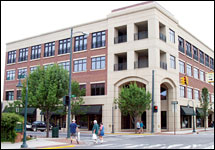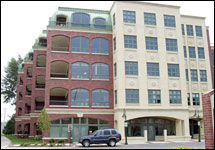MLUI / Articles from 1995 to 2012 / Traverse City’s New Economy Rises on Old Brownfields
Traverse City’s New Economy Rises on Old Brownfields
Grants, loans, and expertise propel a coastal community
January 9, 2006 | By Keith Schneider
and Mac McClelland
Great Lakes Bulletin News Service
 | |
| Mac McClelland | |
Traverse City’s Radio Centre |
Even before 1995, when local leaders first dived into Michigan’s new brownfield law and came up with millions to clean up and redevelop their community, Traverse City was already one of the Midwest’s most inviting places.
Editors from national lifestyle and business magazines swam at the public beaches, kayaked the Boardman River, shopped family-owned stores on Front Street, visited quiet neighborhoods with handsome historic homes, and then returned to faraway offices and proclaimed Traverse City terrific.
What those visitors missed, though, was Traverse City’s 20th-century toxic legacy as a center of lumbering, shipping, food processing, and manufacturing: Large, empty spaces existed where the old economy’s factories, fuel stations, and depots once stood and where industrial contaminants too expensive to remove still lurked. Like most other Michigan towns, Traverse City’s brownfields limited its ability to recruit new businesses, workers, and residents that would help the community thrive in a new economy.
A City Transformed
Now, ten years after local leaders started their first brownfield projects, those magazine editors would see a city of 15,000 residents rebuilding its downtown, modernizing its parks and public spaces, and achieving new civic dynamism. Construction is yielding five-story, mixed-use buildings along the Boardman, new downtown office buildings, architecturally distinguished parking decks, midtown residences, and one of America’s most ambitious historic restoration projects.
Almost all of this renewal flows from the $27 million that public officials and developers gathered from Michigan’s brownfield redevelopment program. In fact, through 2004, Traverse City secured more brownfield incentives than the next two cities, Detroit and Lansing, combined.
What made Traverse City a hub of brownfield activity? Public officials learned the requirements of brownfield redevelopment programs and formed business and political partnerships to tap the Lansing-administered accounts. “Planning, partnerships, and perseverance make brownfield redevelopment possible,” said Bryan Crough, director of the City’s Downtown Development Authority and an architect of the city’s brownfield redevelopment success.
Of course, Traverse City is an attractive place for state investments: It is the economic and cultural center for a five-county region of 165,000 people, and is determined to keep improving its economy, environment, and quality of life.
Planning and Leadership
In 1997 the city rewrote its master plan to reflect a popular desire to be a clean, green capital of the active lifestyle that was becoming a new engine of civic dynamism. The plan called for replacing many of the downtown parking lots with homes, businesses, shops, and offices. The city wanted to embrace the human-scaled, pedestrian-friendly, auto-independent design that Traverse City’s original planners used around the community’s founding, in 1881.
In 1995, Mr. Crough and the Traverse City Area Chamber of Commerce organized a seminar at the city’s historic opera house to explain what the brownfield redevelopment program could mean for downtown, priming the audience of civic leaders for action.
Among the best candidates for redevelopment was the former Traverse City Iron Works, which had long produced iron castings for industry. The 12-acre site, along the Boardman River a few blocks from Front Street, was abandoned in 1984. Grand Traverse County, which had used a state Coastal Management Program grant in 1992 to assess the property’s environmental condition, knew the location and extent of the contamination from mold sand, iron slag, leaking fuel, and chemical seeps at the old foundry, but did not have the millions needed to clean it up.
But Michigan’s brownfield redevelopment laws had altered the cleanup standards and could provide tax increment financing for brownfield redevelopment. With new grants and loans available to clean up contaminated sites, and a new master plan that supported the sort of dense development that could be built on the ironworks site, the project seemed like a solid opportunity.
River’s Edge
 | |
| Mac McClelland | |
| Traverse City’s River’s Edge |
In 1997, Grand Traverse County established a Brownfield Redevelopment Authority, the state’s second countywide authority. The authority wrote and approved a brownfield plan for the site and applied to the state for brownfield incentives. The city won a $1.5 million state brownfield grant to install a barrier between the river and the core-mold sand and slag on the property.
Those investments, combined with changes in Michigan’s toxic cleanup law, allowed Mr. Burden to complete River’s Edge, a five-story, $12 million brick and glass building, in 1999, on a site left vacant for 15 years.
River’s Edge spurred 10 more brownfield projects, each approved by the county brownfield redevelopment authority and now completed or under construction in Traverse City. The community has realized $90 million in additional private investment, spurred by $5.5 million in approved brownfield redevelopment incentives. Another $165 million in proposed investment is on the way, thanks to an additional $22 million in approved incentives. The result has been 470 new jobs and 180 homes in the Traverse City area.
More Successes
Here are some other important brownfield redevelopment projects in Traverse City:
 | |
| Mac McClelland | |
| Traverse Ctiy’s Harbour View Centre |
→ Radio Centre, a retail and office complex, was developed by businessman Ross Biederman, who completed the first phase, a $4 million, four-story retail and office building, in 2001, the same year the city’s downtown development authority built an $8 million parking deck. He completed the second phase, a $5 million office building, in 2003; a third phase is planned. The development is built on a site that included an abandoned gas station and a car dealership. The county secured a $661,000 state brownfield grant to clean up the two-acre parcel and almost $3 million in tax increment financing, including $1.5 million for the parking deck.
→ The Village at Grand Traverse Commons is the largest brownfield project in northern Michigan and one of the largest in the state. The $100 million-plus project is redeveloping the Italianate former Traverse City State Hospital, which has more than 1 million square feet of historic buildings on a 61-acre wooded campus. The centerpiece is Building 50, a half-mile-long building with two-foot-thick walls, 20-foot-wide hallways, and hundreds of closet-sized rooms.
The project will transform Traverse City’s west side into a new business and entertainment center and is attracting almost every state-financed business incentive available. As a Renaissance Zone, it enjoys state tax benefits. As a brownfield, it receives tax increment financing, single business tax credits, and $2 million in state brownfield cleanup grants. Some new homes are finished, two restaurants have opened, and a number of regional businesses have offices there, including the Michigan Land Use Institute.
“The grants really helped launch the project,” said Ray Minervini, the builder and inspiration behind the grand plan. “Just at the time when the banks were a bit reluctant to back us, the grants came through and provided the foundation for the project financing.”
Keith Schneider is the Michigan Land Use Institute’s deputy director. Reach him at keith@mlui.org. Mac McClelland is the manager of brownfield redevelopment at Otwell Mawby, P.C., in Traverse City. Reach him at mac@otwellmawby.com. To read or download New Plans for Barren Lands in its entirety, click here.





